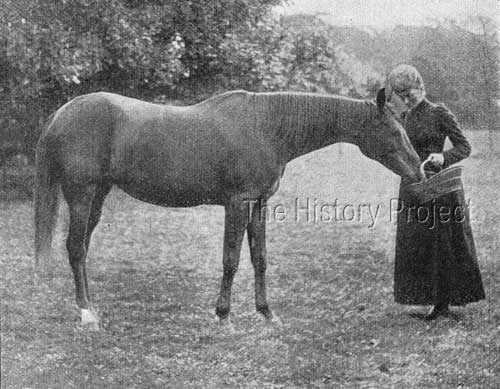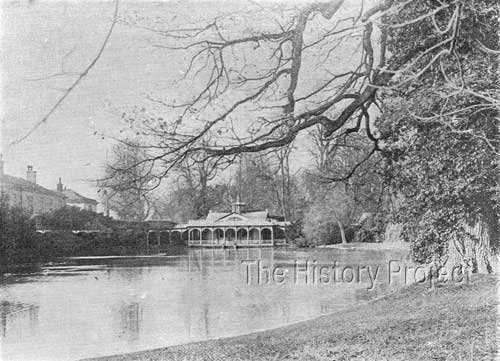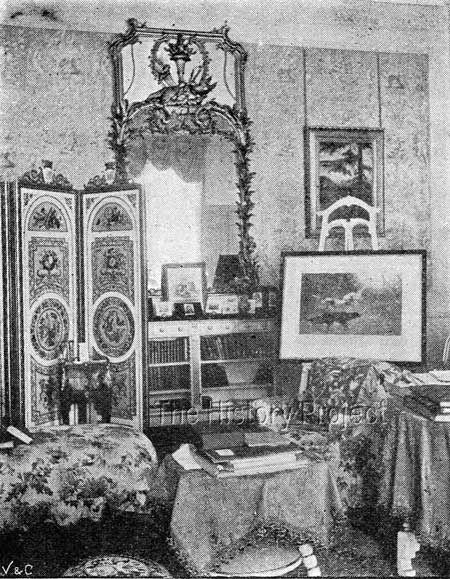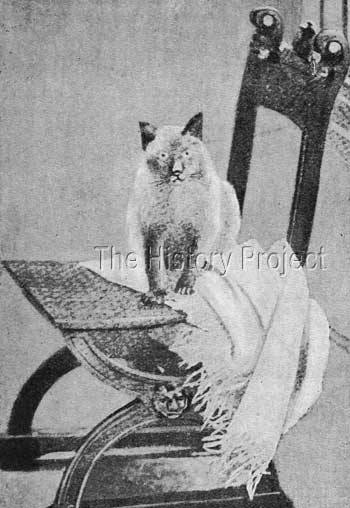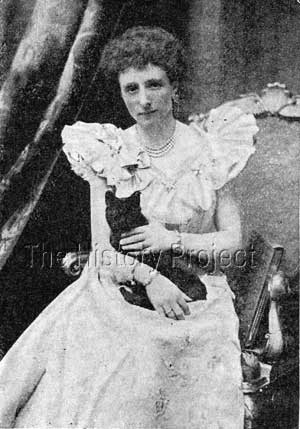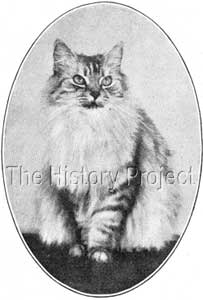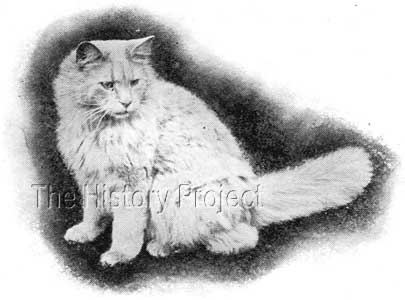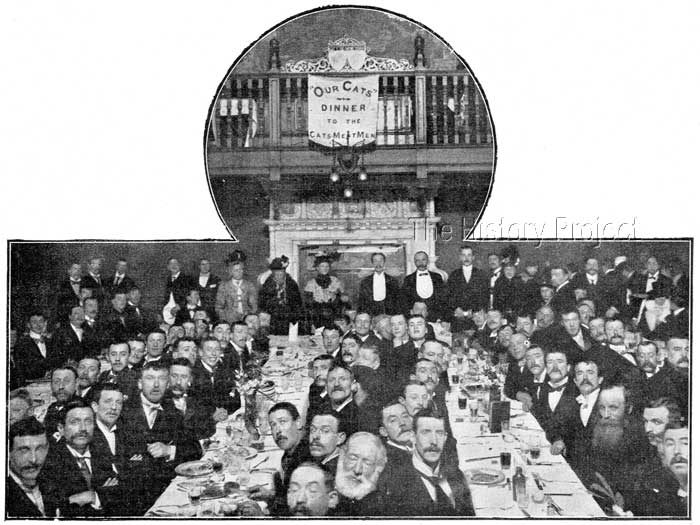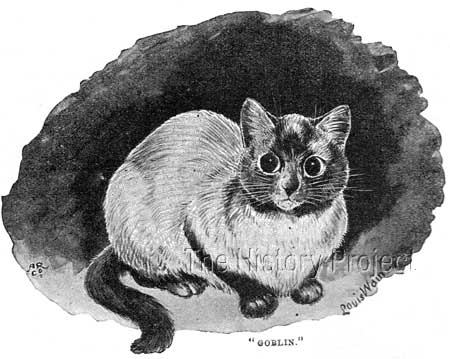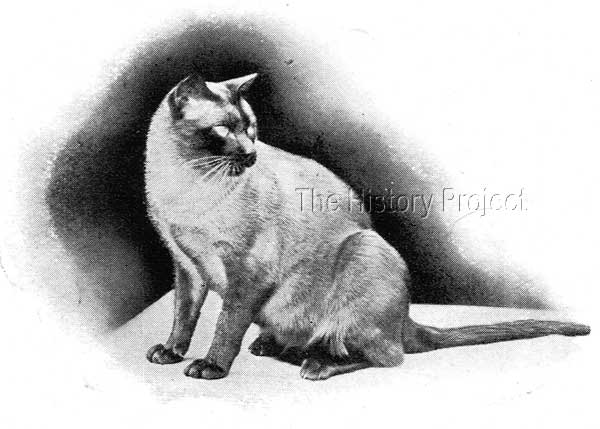 | |||||||||||||||||||||||||||||||









|
GOBLIN (1888)PHOTOS | SOCIAL MEDIA | REFERENCES
HISTORICAL BACKGROUND:Her Grace, the Duchess of Bedford was passionately fond of cats, and in particular, Siamese. She was neither a breeder nor an exhibitor, but did on occasion attend shows, both as a spectator and often as patroness, as well as in her capacity as the titular President of The National Cat Club. Nick-named 'The Versatile Duchess', she was the daughter of a clergy-man, the popular Arch-Deacon Tribe of Lahore, in India, where she spent a part of her childhood. The Duchess was also a very keen sportswoman, and easily ranked as one of the best shots, without distinction of sex, in the kingdom. She was chiefly a philanthropist, who had a passion for the welfare of animals, and on their 3,000 acre estate at Woburn Abbey, the Duke and Duchess inherited a veritable zoo when the Duke succeeded his brother. Being equally devoted to natural history, they soon made even more interesting additions to the collection, both at Woburn Abbey and at Endsleigh, their lovely residence near Tavistock. Their only child, the Marquis of Tavistock, was said to have known more about animals and their ways than any other boy of his age in the kingdom, and was said to have inherited his mother's remarkable power of taming wild beasts by kindness and kindness alone. The stables in particular at Woburn were extensive, and we get a glimpse of their size and character from a brief report on them by Louis Wain: "From the house to the stables (the latter almost as extensive as the house itself) is but a walk across the snow-covered sward, skirting a gigantic cedar. A lift of the latch opens the door into the harness-room, and here hang saddles of very early date side by side with others of the latest and most improved workmanship.2 "The horses are never ending; you see some of them at most times out exercising. At the entrance to each set of stables a basket of carrot slips is placed on a ledge, and many a head is turned wistfully eyeing the coveted feast. Almost the first to lick the hand that feeds him, by way of thanks, is a well-groomed gentle zebra, who remains unnamed for the present. She is ridden in the riding school by a boy, but it takes two people to lead her at the same time.2 "Many old friends whose days are numbered live out their span in comfort and peace, a plate at the back of their stalls records the name of each."2
Among their many philanthropic ventures, both the Duke and Duchess were Patrons of 'The Society for the Protection of Cats', through which the Duchess maintained a 'Home for Starving and Forsaken Cats' at Gordon Cottage in Hammersmith.7 One classic example of the Duchess's generosity was her singular involvement and support for the Our Cats Magazine's tributary dinner, for the 'Cat's Meat Men' of London, which was held at the 'City of New York' restaurant in Holborn, in January 1901. This event is covered in more detail below, but curiously enough, in a twist of fate, resulted in the Duchess unexpectedly acquiring a new pet cat, who came to reside in the stables at Woburn Abbey.6 As President of The National Cat Club, the Duchess of Bedford was a prominent figure in the world of cats. She gathered around her a number of aristocratic and well-known ladies of substance, all true friends of the cat, who worked hard together to encourage good breeding and to popularise open competition. The story of one of her favourite cats is that of a much-loved 'pet', that just also happened to be a 'Siamese' of considerable beauty and of early and famous ancestry. PARENTAGE & OWNERSHIP:
Unknown
Tiam O'Shian (I)
| Unknown
Goblin, 1888, Seal Point Siamese, N
| Unknown
Susan
Unknown
Thanks to the efforts of Major E. Sydney Woodiwiss, who compiled The Siamese Register published in 1924, we find a listing for 'Goblin' giving a date of birth as 1888, his sire as the imported male 'Tiam O'Shian I', his dam as 'Susan', and his breeder as Miss Forestier Walker. The listing also confirms that he was a neuter, and belonged to the Duchess of Bedford.10 His breeding is significant, as he comes from two of the most significant cats to be imported from 'Siam' during the mid 1880's. His dam 'Susan', was one of an original pair sent to Mrs. Vyvyan and her sister in circa 1885, while they were vacationing in China. In Harrison Weir's book Our Cats, published in 1889, Mrs. Vyvyan is recorded as saying: "The original pair (referring to 'Susan' and 'Samuel') were sent from Bangkok and it is believed that they came from the King's Palace, where alone the breed are said to be kept pure. At any rate, they were procured as a great favour, after much delay and great difficulty, and since that time no others have been attainable by the same person. We were in China when they reached us, and in the following year, 1886, we brought the father, mother, and a pair of kittens to England."9 'Goblin's' sire, the original 'Tiam O' Shian' (aka Tiam O'Shian I), we are told also came from Bangkok, and is likely to have been one of the imports that followed a year later. From this famous foundation male, all the 'Tiam OShian's' are descended and he is largely the backbone behind an enormous number of the early pedigreed Siamese cats. The only first-hand report we have, giving an enlightened description of 'Goblin' comes an article about the Duchess of Bedford's pets, from the pen of Mr. Louis Wain himself who, as Chairman of the Committee of The National Cat Club, visited the Duchess of Bedford, the titular President of The National Cat Club, in her stately home at Woburn Abbey, in 1895.
"The first impression a stranger receives on viewing the great home of the Russells is a feeling of absolute repose. Everything combines to produce this effect - the fine unpretentious front, severe in classical massing, backed by elms and the famous Woburn beeches of immense growth and immemorial age, the delightful park-land lying around, the graceful deer wandering undisturbed among the quiet glades, all speak an atmosphere of eternal peace. Passing through the gateway, embedded in firs and laurels, a short walk brings one close to Woburn Great House; but before one even enters the massive old hall, one encounters some of the many pets to which the charming mistress of Woburn is so devoted.2 "On a smooth lawn in front, from which the thick snow has been cleared, throngs of gossiping, chattering birds are making the most of an hour or two of bright winter sunshine; tits are grubbing about with praiseworthy industry; starlings and thrushes hop superciliously among plebeian sparrows, while robins try to sing each other out of countenance on neighbouring branches.2 "Once indoors, we pass down the scarlet corridors, hung with many famous family portraits, to the Duchess of Bedford's sitting room, which by courtesy, is also the cats boudoir, and here we are introduced to a few of the more distinguished members of a very important section of the family circle."2
Mr. Wain then describes in some detail, a long-haired brown tabby pet cat, named 'Tommy' before setting his attention on the subject of our missive: "On a fur rug, a really royal Siamese cat sits, blinking in the glow and glint of the fire. His glossy coat is of a cream and mouse-brown colour, while his eyes are of a pale blue-mauve. It would be difficult to find 'Goblin's' match at a show or elsewhere in this country; small wonder that he is a popular sprite. Yet his grave innocent expression of countenance is a huge fraud, for at any moment he is ready to sacrifice the whole of his dignity at one fell swoop for a romp and a scramble, despite the four years which he numbers."2 From this, we could happily be forgiven for deducing that 'Goblin' was born as late as 1891, were it not for the fact that he is to found in the Siamese Cat Register, compiled many years later, by Major E. Sydney Woodiwiss, with his date of birth in 1888. So when Mr. Louis Wain saw him at Woburn, he would have in fact been seven years of age, which matches more closely with another photograph of 'Goblin' where he is seen with the Duchess of Bedford's young son, the Marquis of Tavistock. Mr. Wain goes on to inform us about another Siamese cat, then resident at Woburn Abbey: "'Bogie,' a whole-colour, very dark-brown cat, is likewise a Siamese, and a vixen into the bargain. She has a philosophy of her own in regard to the treatment of furniture, and will play sad havoc with silk, damask and even 'down' cushions when she gets the chance. Consequently she is usually banished to an upper storey, or the grass lawn, whereon to work her wicked wiles."2 He then describes a reddish tabby long-hair, nick-named 'Bill Beresford' on account of the fact that he was a gift from Lord William Beresford, before telling us about a third Siamese cat in residence: "Other cats are frequently permitted to join the house or garden party, but some, alas! are by nature so indigenously and irretrievably wicked that their sojourn in polite society has to be of a very limited duration. 'Bigit,' for example, is on the roll of the tabooed; he is a sullen Siamese, who lives happily enough in exile, where twenty-five guinea pheasants are unknown, and the larder door balks his sportive inclinations, and where his liberties are entirely circumscribed to the domestication of home life alone."2
From an unknown author, writing about 'Cats as Society Pets' for The Boudoir in February 1904, we learn of the affection of the Duchess for 'Goblin': "I give the picture of 'Goblin' though he is of the past, as I know her Grace was extremely fond of him, and, if my memory is true, she wears his picture in a tiny locket made to contain the likeness of each of the cats she made personal pets of in, and since the days of her childhood in India."1 SIBLINGS & SHOWS:We find three Siamese registered from this early breeding, all likely to have come from a common birth date in 1888. They were 'Goblin', and 'Loquat' (retained by Miss Forestier Walker for breeding) and 'Satu'.10
Interestingly, 'SATU' must have first been sold by Miss Forestier Walker to Lady Russell for breeding, as she is the dam of record of both 'Vashti',(born in 1890) and 'Chowfa'(born in 1892). 'Satu' is later recorded as owned by the Duchess of Bedford, in The Siamese Cat Register. Her son 'Chowfa', is shown as also owned initially by Lady Russell, but the second owner of record is also the Duchess of Bedford. This would tend to support claims that the Duchess was particularly fond of Siamese cats. 'Satu's' famous daughter, 'Vashti' went on to be the progenitor of a veritable dynasty of Siamese, mostly through her daughter 'Susa', who was the dam of amongst others: Mrs. Chapman's 'King Wallypug'(b.1896), Mrs. Vyvyan's 'Tiam O'Shian III' (b.1894), Lady Decies 'Fulmer Banjo' (b.1896), and The Hon. Mrs. McLaren Morrison's 'Princess of Siam', 'Siam' and 'Bangkok of Kepwick' (b.1895). So 'Satu', and her son 'Chowfa', both ended up as beloved pets with Her Grace the Duchess of Bedford. 'Goblin's' other sister, 'LOQUAT', who was retained by Miss Forestier Walker as a breeding queen, became the dam of one important female, 'Mrs. O'Shian' (b.1889), who in her turn was the dam of 'Priscilla' the dam of the famous 'Polyphema' prime progenitor of a second dynasty which included such cats as Mrs. Vyvyan's 'Tiam O'Shian IV',(b.1899) Mrs. Backhouse's 'Ch. Eve', b.1899, and Mrs. M. Robinson's lovely 'Ah Choo', b.1900, amongst others.
It has been said that the Duchess never exhibited cats, but that she was not an exhibitor from the dislike of cat shows, for she realised that these fixtures were a great protection to the cat, 'making Puss of such commercial value, that its happiness and safety in living is assured'. Accordingly she gave her patronage to the leading exhibitions of cats, giving the costliest of prizes. 'FRITZ' and 'NAPOLEON' Writing about Her Grace's interest in the welfare of cats, the reporter Walter T. Roberts, records from an interview with the Duchess in 1903, the incidences of how two of her pets came to be adopted: "The Duchess of Bedford has for several years taken a very considerable interest in the welfare of cats, and is also a generous patroness of many institutions for pussies. The extent of Her Grace's catteries however been somewhat exaggerated. They have been described as 'celebrated and extensive'. As a matter of fact, the Duchess of Bedford (now) owns exactly two cats, and neither of these two animals has ever competed for a prize in its life. Her Grace was kind enough to relate to me the circumstances under which these two cats came into her possession.5 "One of them - a silver tabby Persian- now named 'Fritz', was found in an area near St. James' when quite a little kitten, and two years later arrived at the Duchess's house in Belgrave Square where he has found the kindest of mistresses and a most comfortable home for the past seven years.5 "The history of the other cat I give exactly as it was told to me by her Grace: 'I have one other cat in the stables - a black and white English one of unparalleled ugliness, rescued by a woman in North London from cruelty and starvation and sent by her to be destroyed in a lethal chamber. It escaped and returned to her. Not having the heart to send it back, and having heard of me through the cats-meat man, she brought it to my protection. He was christened "Napoleon", (being a cat with a past), and is now a sleek and well-to-do pussy."5
'FRITZ' and 'GOBLIN' In another report, written a year later, we are given further clarity on the arrival 'Fritz' to the Duchess's household, as well as his 'love-hate' relationship with the Her Grace's favourite, the Royal Siamese 'Goblin': "Of the cats which the Duchess now has, there is only one indoors, viz., the veteran 'Fritz', 'nine and a half years old. As a kitten he fell into an area near St. James's Street, and, being too small to find his way home again, was taken care of by the secretary of The Courier Club. He must have been of aristocratic parentage, as he is a handsome silver tabby Persian. He came to her Grace when two years old.1 "During 'Goblin's' lifetime he was a somewhat ill-tempered and morose little cat, as the Siamese always took an unholy delight in springing out upon him unawares from behind doors and screens, really only from playful motives, but 'Fritz's' London education had probably taught him to take a serious view of life, and he looked upon these jokes as unseemly.1 "'From the day 'Goblin' died, 'Fritz' became an altered cat: screens and doors were no longer objects of suspicion to him, and to his human friends he has become an affectionate and good-tempered little cat. He resents all interlopers in the shape of dogs or other four-footed animals, but has no objection to birds."1 'OUR CATS' - THE DINNER for the 'CATS-MEAT MEN' of London In the movement to secure better treatment for waif and stray cats, the Duchess also promoted and largely paid for a most successful supper, for the 'Cats'-Meat Men' of London. The idea for the dinner was initiated and sponsored by 'Our Cats' Magazine. Frances Simpson, who attended the dinner in person, informs us in The Book of The Cat (1903) that the supper was: "organized by the editor of 'Our Cats', assisted by Mr. Louis Wain and others." and that, "applications for the tickets were so numerous, that 400 men had to be refused; and when the 250 guests were seated, it was clearly proved that every available inch of accommodation had been utilised. Having been present, I can testify as to the excellent supper and entertainment provided for the cats'-meat men of London."8 The event was reported in some detail, in the current events columns of 'Black and White Budget', on 26th January, 1901, supported by the below photograph of the dinner guests.
"CATS'-MEAT men of the metropolis were highly honoured the other evening at the dinner and entertainment arranged on their behalf at the City of New York Restaurant, Holborn, by a letter from the Princess of Wales expressing her Royal Highness's best wishes for its success, and her regret that absence from London prevented her having the pleasure of being present. Mr. Louis Wain, the famous cat artist, presided, and, rapping on the table with a soda-water bottle, explained that the gathering was not a charity, but the guests were invited as cat-lovers, and met as 'pals'. Visitors were impressed by the youth of many of the vendors of pussy's favourite dainty. They were a hilarious assemblage, and greeted the appearance of the soup, the roast beef, and the boiled legs of mutton with prolonged cries of "Mee-att!" in the familiar notes of the street. At the end of the repast, Mr. Wain said that all knew the old tom who ran after the cart and 'sneaked' his ha'porth, and her who said 'Meaow' till she got her bit. They were all right, but he appealed for pity for those poor cats who by chance, circumstances or cruelty were thrown out into the world."6 "During the dinner, the Duchess of Bedford rendered invaluable assistance by passing the sprouts at a critical juncture. Lady Reid was there, and Mrs. Stennard Robinson of the Ladies Kennel Association; also the editor of 'Our Cats', by whose efforts the dinner was organised. By the nature of his calling the cats'-meat man's voice is singularly well developed, and as the evening went on things became very merry. Several theatrical people very kindly came and sang, Mdlle Janotha brought her cat, and the Duchess of Bedford gave the men 250 half-pound tins of tobacco."6 PHOTOS:
SOCIAL MEDIA :
SUMMARY: Although a neutered pet, and despite not being a show cat of record, the image of 'Goblin' provides us with only visual connection we have to Mrs. Vyvyan's original Siamese import out of Bangkok, 'Tiam O'Shian'. It is through seeing 'Goblin' that we can begin to have an insight into his full siblings 'Satu' and 'Loquat', and sire siblings, 'Tiam O'Shian II', 'Mrs. O'Shian', 'Priscilla' and 'Puppy'. So although we have no photographic record of any of these cats, the image and story of 'Goblin' are indicative of what we could possibly have expected from each of his siblings, in either phenotype and or personality. That the Duchess of Bedford also took in 'Satu' and 'Chowfa', 'Bogie' and 'Bigit', stands testament to her particular fondness for, and devotion to, the breed. And it is thanks to her singular love of 'Goblin' that we have this insight today. REFERENCES:
Registers associated with this article include The Incorporated Cat Fanciers Association of Great Britain (TICFAGB), National Cat Club (NCC), The Cat Club (CCR), Beresford Cat Club (BCC), Feline Federation Francaise (FFF), Siamese Cat Registry (SCR), US Register & Studbook for Cats (USR)including Supplement(USRS), The Studbook of the American Cat Association (ACA), and the Studbook & Register of the Cat Fanciers' Association (CFA).
|
||||||||||||||||||||||||||||||
Home | Cats | Gallery | Clubs | People | Artifacts | Articles | Updates | Contact Us ©The CFA Foundation, Inc and The Harrison Weir Collection
|
|||||||||||||||||||||||||||||||

